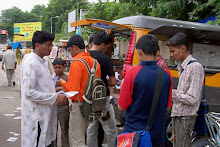Sify
News: Columns: Tuesday, 06 October 2015.
So it’s been
10 years since the Right to Information Act started working in India. It came
as a welcome relief for the citizens of
India who used to find themselves banging against a brick wall when they tried to get even simple
information out of government officials.
Looking at 10
things about RTI which you may or may not know…
1.
RTI kaun laya?
Who brought RTI to India? For that many can claim credit. First the Mazdoor
Kisan Shakti Sangathan (MKSS) was founded in 1987 by Aruna Roy and Nikhil Dey.
It was one of the very first campaigners for such a concept.
That led to the National
Campaign for People's Right to Information (NCPRI) in 1996. In the very same
year the Press Council of India formulated a draft on the issue. Immediately
after that many RTI Acts were introduced in States like Tamil Nadu and Goa in
1997. This was followed by Delhi (2001) and Karnataka and Rajasthan (2002).
Consumer Rights champion
HD Shourie was roped in by the NDA government and that led to the Freedom of
Information Act of 2002. It finally became a full-fledged reality called RTI
during UPA1 in 2005.
2.
Why it was necessary: To counter the Official Secrets Act 1923. It is amazing
how much British legislation remained untouched after 1947 and quite a lot of
it is unaltered to this very day. While the Secrets Act was initially an anti-espionage
measure, later it was used by the government to protect anything.
Like the Act stated that
citizens couldn’t even “approach, inspect, or even pass over a prohibited
government site or area”! The RTI Act of 2005 finally countered it and it was
further watered down by a court ruling in 2009.
3.
Applicability:
The law talks of “access to information under the control of public
authorities”. That means that any citizen in India can approach any “public
authority” of a body of Government or “instrumentality of State” for the same.
There is a 30 day limit for a reply.
In fact the ambit was
widened even further and made applicable for bodies “owned, controlled or
substantially financed” by the Government.
4.
Exclusions:
There is also a move to bring political parties into the Act. Agencies like
CBI, IB, RAW, ED etc are excluded. Also is information that may affect the
security and sovereignty of India, that which has been withheld by a court or
that which comes under the privileges of Parliament and State Assemblies.
5.
Very first RTI application: On October 12, 2005, a person called
Shahid Raza Burney submitted India’s first ever Right To Information
application to a police station in Pune and thus we entered the RTI age.
6.
J&K remains special: Article 370 of the Constitution
confers a special autonomous status to Jammu & Kashmir. And it is out of
the ambit of the RTI too. However it’s not that they don’t have access. They
have to rely on the Jammu and Kashmir Right to Information Act of 2009.
7.
RTI successes:
Overall it has been hugely successful and has helped citizens get crucial
information. One of the biggest successes has been getting information in the
Adarsh scam. It also helped expose corruption in the Public Distribution System
in Assam.
While there are national
and State level scams, it has helped unearth hundreds of wrongdoings at the
local level.
8.
RTI deaths:
While RTI activism became an industry, attacks on RTI activists followed. The
number of such attacks now number hundreds and dozens have been killed. Lalit
Mehta was exposing a NREGA scam and was killed in 2008.
Satish Shetty was exposing
land scams in Maharashtra and was stabbed to death in 2010. In the same year
Amit Jethwa was shot in the Ahmedabad High Court complex. He was exposing a
mining scam. There are many such stories which talk of the bravery of RTI
activists.
9.
Other counties have it too: America led the way when President
Lyndon Johnson signed the Freedom of Information Act in 1966. Other countries
too followed though many took decades to do so. However America did have a
rethink and they curbed it via the Privacy Act of 1974.
10. 10 rupees:
That’s the application fee. However the applicant may have to subsequently pay
more towards the cost of providing the actual information. There are provisions
to make requests online too.














































































